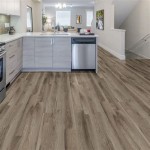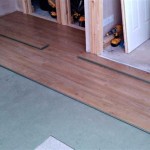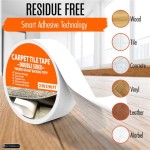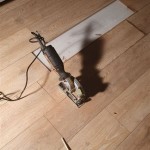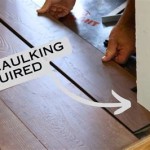Is Luxury Vinyl Plank Flooring Toxic To Dogs? A Comprehensive Overview
Luxury Vinyl Plank (LVP) flooring has surged in popularity as a durable, aesthetically pleasing, and relatively affordable alternative to hardwood and other traditional flooring options. Its water resistance, ease of maintenance, and realistic wood-look designs have made it a favorite among homeowners. However, pet owners, especially dog owners, often raise concerns about the potential toxicity of LVP flooring and its possible impact on their canine companions' health. The question of whether LVP flooring is toxic to dogs is multifaceted and requires careful consideration of the materials used, manufacturing processes, and potential exposure routes.
Understanding the composition of LVP is crucial to assessing its potential toxicity. LVP flooring is typically constructed from several layers. The base layer provides stability, followed by a core layer that adds rigidity and water resistance. A decorative layer provides the visual appeal, mimicking the look of wood, stone, or tile. Finally, a wear layer protects the decorative layer from scratches, stains, and general wear and tear. The materials used in each of these layers can vary between manufacturers and product lines, contributing to the diverse range of LVP flooring products available on the market. Some of these materials, if not properly controlled, may pose a risk to dogs.
One of the primary concerns regarding the toxicity of LVP flooring is the presence of volatile organic compounds (VOCs). VOCs are chemicals that evaporate at room temperature and can be released into the air, potentially affecting air quality and posing health risks. Common VOCs found in building materials include formaldehyde, benzene, toluene, ethylbenzene, and xylene. Exposure to high levels of VOCs can cause a range of symptoms in humans and animals, including eye, nose, and throat irritation, headaches, nausea, dizziness, and respiratory problems. Long-term exposure to certain VOCs has been linked to more serious health issues, such as cancer.
Phthalates are another group of chemicals that have raised concerns regarding the toxicity of LVP flooring. Phthalates are plasticizers, added to vinyl to make it more flexible and durable. Some phthalates have been shown to disrupt the endocrine system, potentially affecting hormone regulation and reproductive health. While the use of certain phthalates has been restricted in children's products in some countries, their presence in flooring materials remains a concern for pet owners, particularly given dogs' tendency to lick and chew on surfaces.
Heavy metals, such as lead, cadmium, and mercury, are another potential source of toxicity in LVP flooring. While the use of lead in building materials has been largely phased out in many countries, older flooring materials may still contain lead. Cadmium and mercury, though less common, can also be found in some flooring products. Exposure to heavy metals can have detrimental effects on the nervous system, kidneys, and other organs. Dogs, especially puppies, are more vulnerable to the toxic effects of heavy metals due to their lower body weight and developing organ systems.
Key Point 1: Understanding the Sources of Potential Toxicity in LVP
Identifying the potential toxic components within LVP flooring necessitates a closer look at the materials and manufacturing processes involved. As previously mentioned, VOCs, phthalates, and heavy metals represent the major areas of concern. The specific types and concentrations of these substances can vary significantly depending on the manufacturer, the type of LVP flooring, and the quality control measures implemented. Lower-quality or less expensive LVP products may be more likely to contain higher levels of harmful chemicals compared to higher-end, certified products.
The manufacturing process also plays a crucial role in determining the potential toxicity of LVP flooring. During the production of LVP, chemicals are used to bind the different layers together and to create the desired appearance and performance characteristics. The use of formaldehyde-based adhesives, for instance, can contribute to VOC emissions. Similarly, the addition of phthalates to the vinyl layer can increase the potential for exposure. Proper ventilation and emission control measures during manufacturing can help to reduce the levels of harmful chemicals in the finished product.
Importantly, the age of the LVP flooring can also influence its toxicity. Newly installed LVP flooring tends to emit more VOCs as the chemicals off-gas from the material. Over time, the rate of VOC emissions typically declines, but some chemicals may continue to be released for months or even years. Therefore, it is advisable to ventilate the area well after installing new LVP flooring to minimize exposure to VOCs.
Key Point 2: How Dogs May Be Exposed to Toxic Substances in LVP
Dogs can be exposed to potentially toxic substances in LVP flooring through several routes, including inhalation, ingestion, and dermal contact. Inhalation is the most common route of exposure, especially for VOCs. Dogs, like humans, breathe in the air surrounding them, and if the air contains elevated levels of VOCs released from the LVP flooring, they can inhale these chemicals into their respiratory system. Smaller dogs and dogs with pre-existing respiratory conditions may be more susceptible to the effects of VOC inhalation.
Ingestion is another potential route of exposure, particularly for puppies and dogs that have a habit of chewing or licking surfaces. If a dog chews on LVP flooring, they may ingest small particles of vinyl and any chemicals contained within it. Licking the floor can also result in the ingestion of chemicals that have leached from the LVP material. The amount of chemicals ingested will depend on the frequency and duration of chewing or licking, as well as the concentration of chemicals in the flooring.
Dermal contact occurs when a dog's skin comes into direct contact with the LVP flooring. While the skin provides a protective barrier against many chemicals, some substances can be absorbed through the skin, especially if the skin is damaged or irritated. Prolonged contact with LVP flooring may lead to dermal irritation or allergic reactions in some dogs. Additionally, if a dog's paws become contaminated with chemicals from the flooring, they may ingest these chemicals when grooming themselves.
It is important to consider that puppies are generally more vulnerable to the effects of toxic substances due to their developing organ systems and higher metabolic rate. They also tend to explore their environment by putting things in their mouths, increasing the risk of ingestion. Therefore, extra precautions should be taken to protect puppies from potential exposure to toxic substances in LVP flooring.
Key Point 3: Mitigation Strategies and Safer Alternatives
Addressing the concerns about the potential toxicity of LVP flooring requires proactive measures to minimize exposure and choose safer alternatives. Selecting LVP flooring products that are certified by reputable third-party organizations is a crucial first step. Certifications such as FloorScore, GreenGuard, and SCS Global Services indicate that the product has been tested and meets stringent standards for VOC emissions and chemical content. These certifications provide assurance that the LVP flooring is safer for indoor air quality and human and animal health.
Proper ventilation is essential during and after the installation of LVP flooring. Opening windows and doors to allow fresh air to circulate can help to reduce the concentration of VOCs in the air. Using air purifiers with HEPA filters and activated carbon filters can also help to remove VOCs and other pollutants from the air. Maintaining good ventilation in the home, especially in areas where dogs spend a lot of time, is important for minimizing their exposure to airborne chemicals.
Cleaning LVP flooring with gentle, non-toxic cleaning products can help to prevent the build-up of dust and debris that may contain harmful chemicals. Avoid using harsh chemicals or abrasive cleaners, as these can damage the flooring and potentially release more VOCs. Regularly vacuuming or sweeping the floor can also help to remove dust and allergens.
Consider using area rugs or mats in areas where dogs spend a lot of time. Rugs and mats can provide a barrier between the dog and the LVP flooring, reducing the risk of dermal contact and ingestion. Choose rugs and mats made from natural, non-toxic materials, such as cotton, wool, or jute. Wash rugs and mats regularly to remove any accumulated dust or debris.
Ultimately, the best way to minimize the risk of toxicity from LVP flooring is to choose alternative flooring materials that are known to be safer for dogs. Natural materials such as bamboo, cork, and linoleum are generally considered to be lower in VOCs and chemical content compared to vinyl flooring. Hardwood flooring, especially when finished with non-toxic sealants, can also be a good option. When considering alternative flooring materials, it is essential to research the specific products and manufacturers to ensure that they meet safety standards and are free from harmful chemicals. Consultation with a veterinarian or environmental health professional can provide valuable insights and guidance in making informed decisions about flooring materials for homes with dogs.
The information provided in this article serves to enhance understanding about the potential toxicity of LVP flooring to dogs and highlight the importance of informed decision-making. Ongoing research and advancements in material science will continue to shape the landscape of safer flooring options.

How Lvp Flooring Holds Up With Dogs Tips And Insights

How To Choose The Best Flooring For Dogs Home

Best Flooring For Dogs That Floors Paws

How To Choose The Best Flooring For Dogs Home

Is 12 Mil Wear Layer Enough For Dogs Find Out Now Villagio

7 Best Flooring For Dogs Durable Stylish Villagio

Pet Friendly Flooring For Dog Owners Choices
Vinyl Flooring For Dogs Pets Pet Proof Plank Tile

How To Choose The Best Flooring For Dogs Home
.png?strip=all)
What S The Best Dog Friendly Flooring America
See Also
